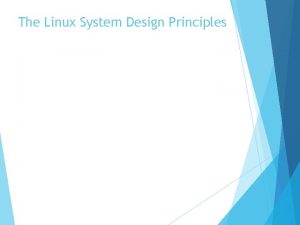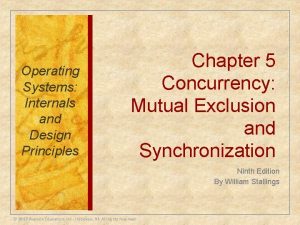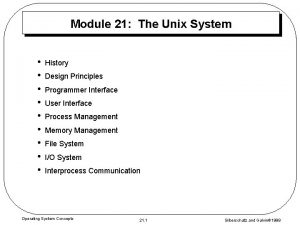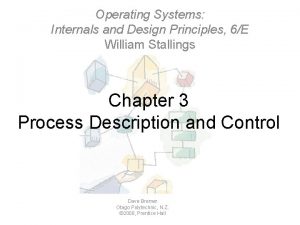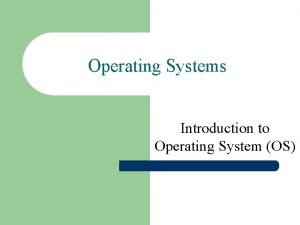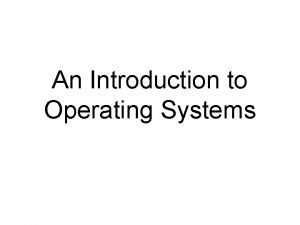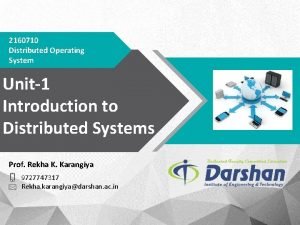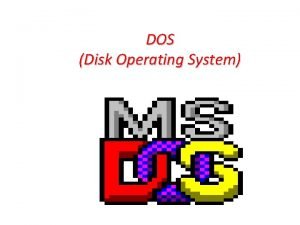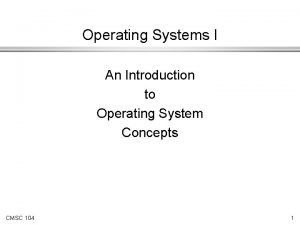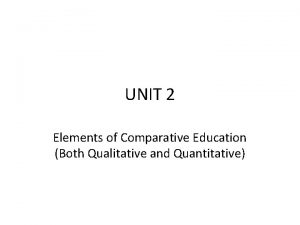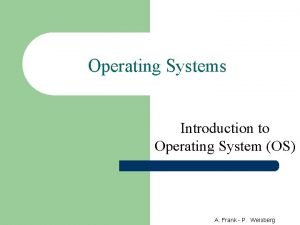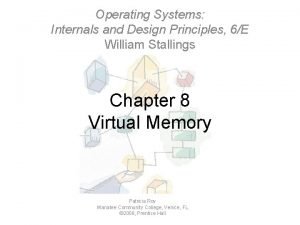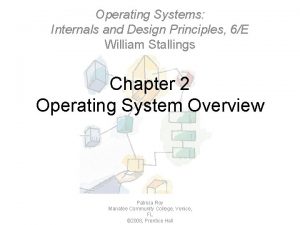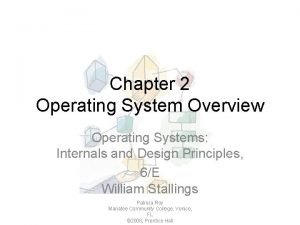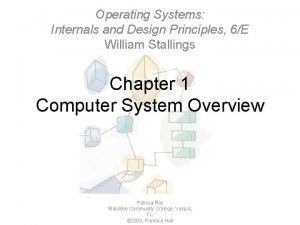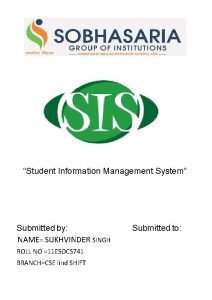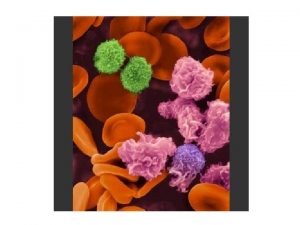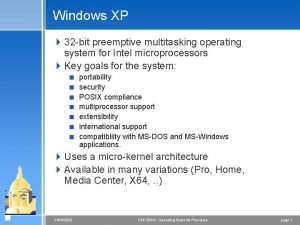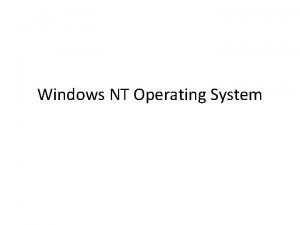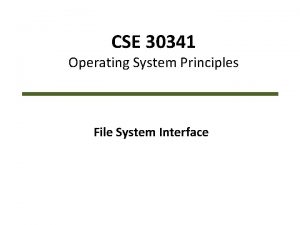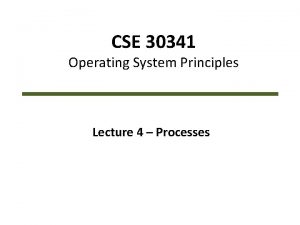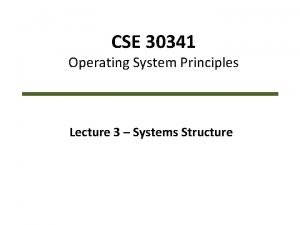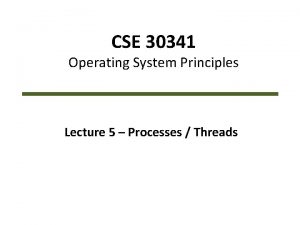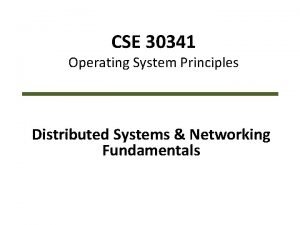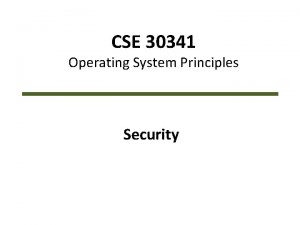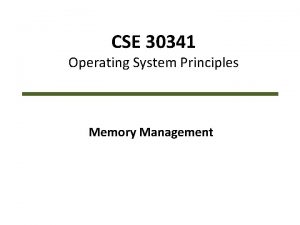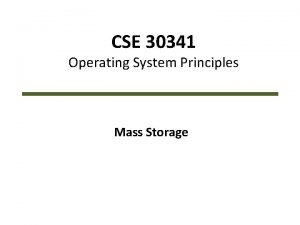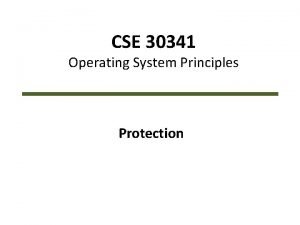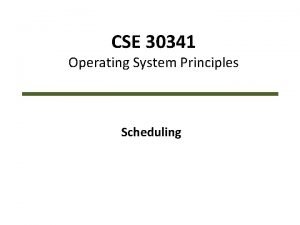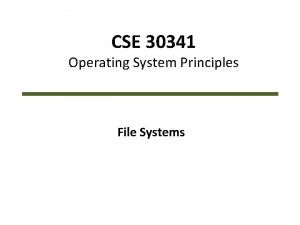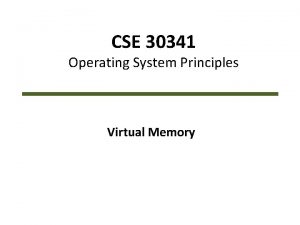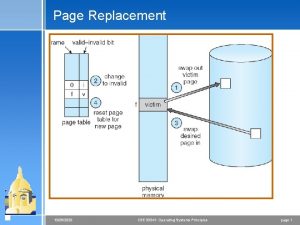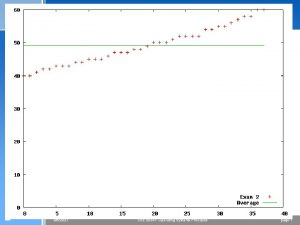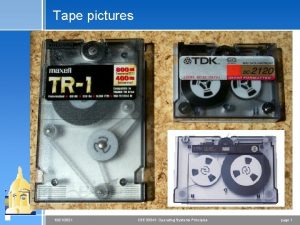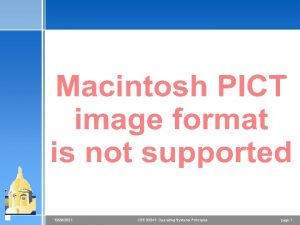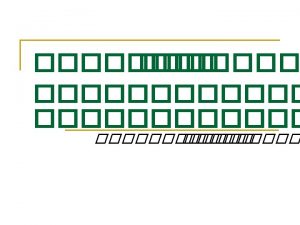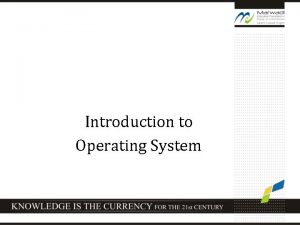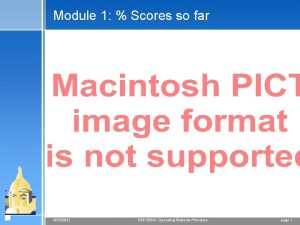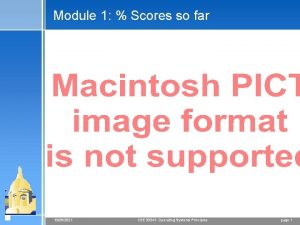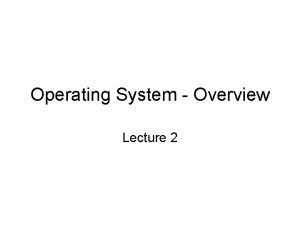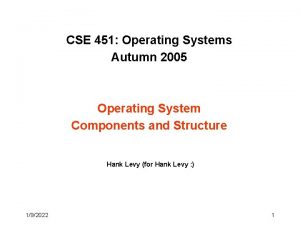CSE 30341 Operating System Principles Lecture 2 Introduction






































- Slides: 38

CSE 30341 Operating System Principles Lecture 2 – Introduction – Continued

Recap – Last Lecture • What is an operating system & kernel? • What is an interrupt? CSE 30341 – Operating System Principles 2

OS - Kernel CSE 30341 – Operating System Principles 3

OS - Kernel CSE 30341 – Operating System Principles 4

System Architecture CSE 30341 – Operating System Principles 5

Interrupt CSE 30341 – Operating System Principles 6

Interrupt CSE 30341 – Operating System Principles 7

Interrupt CSE 30341 – Operating System Principles 8

Input/Output – I/O • Communication between CPU and “outside world”: – Storage – Network – Keyboard/mouse – Display – Printer –… CSE 30341 – Operating System Principles 9

Input/Output – I/O CSE 30341 – Operating System Principles 10

Interacting with I/O • System-controlled: – “Write this chunk of data to block 8, 783, 486” – “Please give me the data from blocks 7, 345, 286 – 7, 345, 289” • External events (system reacts): – The user is pressing the shift key – Block 3, 285, 001 appears to be bad – Data arrived over a network connection CSE 30341 – Operating System Principles 11

Interacting with I/O • Responsibilities of OS: – Hide peculiarities of hardware devices from the user – Manage hardware devices (“resources”) efficiently – Prevent intentional/unintentional misuse CSE 30341 – Operating System Principles 12

Interacting with I/O • Application requests I/O from OS – Uses specific interface: system calls – Blocking: application will wait until I/O complete – Non-blocking: application will do something else in the meantime (and receive notification from OS when I/O complete) CSE 30341 – Operating System Principles 13

Direct Memory Access (DMA) • CPU responsible for data moving to/from I/O devices • Alternative: let a separate controller do it (DMA) CSE 30341 – Operating System Principles 14

DMA Controller I/O Device D 6 Memory CPU Please copy 500 bytes of data from D 6 to memory location 0 x 8570000 and interrupt me when you are done DMA Controller CSE 30341 – Operating System Principles vs. Read from D 6 Write to Memory …. 15

Storage Structure • Main memory – only large storage media that the CPU can access directly – Random access memory – Volatile • Secondary storage – extension of main memory that provides large nonvolatile storage capacity – Magnetic disks – rigid metal or glass platters covered with magnetic recording material • Disk surface - tracks, subdivided into sectors • The disk controller determines the logical interaction between the device and the computer – Solid-state disks – faster than magnetic disks, nonvolatile • Various technologies • Becoming more popular CSE 30341 – Operating System Principles 16

Storage-Device Hierarchy CSE 30341 – Operating System Principles 17

Storage Hierarchy • Storage systems organized in hierarchy – Size – Speed – Cost – Volatility • Caching – leverage faster storage system; higher layer can be cache for lower layer CSE 30341 – Operating System Principles 18

Caching • One of the most important principles in systems • Information in use copied from slower to faster storage temporarily • Faster storage (cache) checked first to determine if information is there – If it is, information used directly from the cache (fast) – If not, data copied to cache and used there • Cache smaller than storage being cached – Cache management important design problem – Cache size and replacement policy CSE 30341 – Operating System Principles 19

Computer-System Architecture • General-purpose processors (CPU) versus special-purpose processors (controllers) • Multiprocessor systems are now typical – Parallel systems, tightly-coupled systems – Advantages include: 1. Increased throughput 2. Economy of scale 3. Increased reliability – graceful degradation or fault tolerance CSE 30341 – Operating System Principles 20

Symmetric Multiprocessing (SMP) Architecture UMA – Uniform Memory Access • All share the same memory on the same machine, same cost to access. • May have a private cache NUMA – Non-uniform Memory Access • Each processor has its own memory CSE 30341 – Operating System Principles 21

Multi-Core Design • Multiple “cores” on same chip – On-chip communication is fast – Power consumption can be reduced CSE 30341 – Operating System Principles 22

Clustered Systems • Like multiprocessor systems, but multiple systems working together – Connected via LAN (local-area network) – Storage often shared via SAN (storage-area network) – Main reasons: • High availability – Asymmetric clustering (one machine in hot-standby mode) – Symmetric clustering (multiple machines running and monitoring each other) • High performance (HPC) – Applications must be written to exploit parallelization CSE 30341 – Operating System Principles 23

Clustered Systems CSE 30341 – Operating System Principles 24

Operating Systems Concepts A von Neumann architecture CSE 30341 – Operating System Principles 25

Operating Systems Concepts • Multiprogramming (efficiency) – Single user cannot keep CPU and I/O devices busy at all times – Jobs (code & data) organized s. t. CPU always has at least one to execute – Subset of jobs kept in memory – When a job has to wait (e. g. , for I/O), the OS switches to another job CSE 30341 – Operating System Principles 26

Memory Layout for Multiprogrammed System CSE 30341 – Operating System Principles 27

Operating Systems Concepts • Timesharing (multitasking): – Switching between jobs happens so frequently that users can interact with each job while it is running: interactive computing – Response time (e. g. , < 1 second) – Each user has at least 1 program executing in memory (process) – If several jobs ready to run at the same time: CPU scheduling – If processes don’t fit into memory: swapping – Virtual memory allows of execution of partially loaded processes CSE 30341 – Operating System Principles 28

Operating Systems Concepts • Access to resources needs to be controlled: – Simultaneous access – Unauthorized access – “Improper” access (e. g. , too long) • Dual-mode operating systems – User mode (application) – Kernel mode (OS and privileged instructions) – Mode bit indicates current mode (0 = kernel) – Transition via system calls CSE 30341 – Operating System Principles 29

From User to Kernel Mode • Timer to prevent infinite loop / process hogging resources – – Set interrupt after specific period Operating system decrements counter When counter zero generate an interrupt Set up before scheduling process to regain control or terminate program that exceeds allotted time CSE 30341 – Operating System Principles 30

Process Management • Process = program in execution! – Program = passive – Process = active • Process needs resources (CPU, memory, I/O, initialization data, files, etc. ) • Single-threaded process: one program counter (PC) • Multi-threaded process: one program counter per thread CSE 30341 – Operating System Principles 31

Process Management Activities The operating system is responsible for the following activities in connection with process management: • • • Creating and deleting both user and system processes Suspending and resuming processes Providing mechanisms for process synchronization Providing mechanisms for process communication Providing mechanisms for deadlock handling CSE 30341 – Operating System Principles 32

Memory Management • All data in memory before and after processing • All instructions in memory in order to execute • Memory management determines what is in memory and when – Optimizing CPU utilization and computer response to users • Memory management activities – Keeping track of which parts of memory are currently being used and by whom – Deciding which processes (or parts thereof) and data to move into and out of memory – Allocating and de-allocating memory space as needed CSE 30341 – Operating System Principles 33

Storage Management • OS provides uniform, logical view of information storage – Abstracts physical properties to logical storage unit - file – Each medium is controlled by device (i. e. , disk drive, tape drive) • Varying properties include access speed, capacity, data-transfer rate, access method (sequential or random) • File-System management – Files usually organized into directories – Access control on most systems to determine who can access what – OS activities include • • Creating and deleting files and directories Primitives to manipulate files and directories Mapping files onto secondary storage Backup files onto stable (non-volatile) storage media CSE 30341 – Operating System Principles 34

Mass-Storage Management • Usually disks used to store data that does not fit in main memory or data that must be kept for a “long” period of time • Proper management is of central importance • Entire speed of computer operation hinges on disk subsystem and its algorithms • OS activities – Free-space management – Storage allocation – Disk scheduling • Some storage need not be fast – Tertiary storage includes optical storage, magnetic tape – Still must be managed – by OS or applications – Varies between WORM (write-once, read-many-times) and RW (read-write) CSE 30341 – Operating System Principles 35

Performance of Various Levels of Storage • Movement between levels of storage hierarchy can be explicit or implicit CSE 30341 – Operating System Principles 36

Protection and Security • Protection – any mechanism for controlling access of processes or users to resources defined by the OS • Security – defense of the system against internal and external attacks CSE 30341 – Operating System Principles 37

Recap • Key Points – What is DMA? – What is the memory hierarchy? – What is caching? – What is virtual memory? – What is a SAN? – What is the difference between kernel and user mode? CSE 30341 – Operating System Principles 38
 Operating system lecture notes
Operating system lecture notes 01:640:244 lecture notes - lecture 15: plat, idah, farad
01:640:244 lecture notes - lecture 15: plat, idah, farad Principles of linux
Principles of linux Operating system internals and design principles
Operating system internals and design principles Unix design principles
Unix design principles Operating system internals and design principles
Operating system internals and design principles Operating systems internals and design principles
Operating systems internals and design principles Operating system kernel
Operating system kernel What is operating system
What is operating system Oses definition computer
Oses definition computer Processor pool model
Processor pool model Dos internal and external commands
Dos internal and external commands Introduction to windows operating system
Introduction to windows operating system Cse 340 principles of programming languages
Cse 340 principles of programming languages Cse 340 principles of programming languages
Cse 340 principles of programming languages Principles of economics powerpoint lecture slides
Principles of economics powerpoint lecture slides Comparative educational system
Comparative educational system Buddy system example
Buddy system example File system in operating system
File system in operating system Ufs4.0
Ufs4.0 File system in operating system
File system in operating system Introduction to biochemistry lecture notes
Introduction to biochemistry lecture notes Introduction to psychology lecture
Introduction to psychology lecture Introduction to algorithms lecture notes
Introduction to algorithms lecture notes Slidetodoc.com
Slidetodoc.com Operating systems: internals and design principles
Operating systems: internals and design principles Operating systems: internals and design principles
Operating systems: internals and design principles Operating systems: internals and design principles
Operating systems: internals and design principles Operating systems internals and design principles
Operating systems internals and design principles I/o device management in operating system
I/o device management in operating system Scope of student information system
Scope of student information system Power system dynamics and stability lecture notes
Power system dynamics and stability lecture notes Zline 667-36
Zline 667-36 Uphcp
Uphcp Lymphatic system lecture
Lymphatic system lecture Power system dynamics and stability lecture notes
Power system dynamics and stability lecture notes Multitasking operating system
Multitasking operating system Features of windows nt operating system
Features of windows nt operating system What is os
What is os


